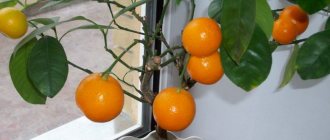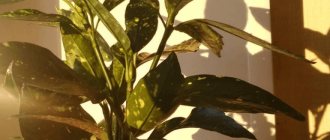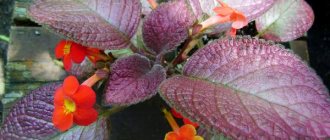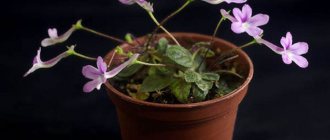Description
First, let's introduce you to this plant. The main decorative effect is provided by multiple branches with amazing leaves, painted in a variety of colors - from green (with its various shades) to blueberry, and some varieties have leaves with original stripes. A cascade of well-groomed plants with lush foliage resembles a magical waterfall. Tradescantia blooms with inconspicuous flowers, which with their appearance do not particularly inspire contemplators, so many design experts recommend cutting off the buds.
Modern breeders are constantly working to create new picturesque varieties of Tradescantia, the demand for which continues to increase, thanks to the simple care of plants and simple breeding methods.
What tradescantia looks like: description of the plant and beneficial properties
A herbaceous plant with creeping stems, leaves almost sessile, ovate or broadly lanceolate, up to 7 cm long, with yellow, white or reddish stripes. Tradescantia flowers look like small umbrellas of purple, reddish, deep blue, light blue or white. They are collected in simple, umbellate or paniculate inflorescences, rarely solitary, with a corolla with three petals; appear in early summer and do not disappear until autumn. Each flower opens for just one day, but the clusters of buds in each inflorescence guarantee long, continuous blooms. It rarely blooms indoors, in spring - summer.
Reproduction methods
The best time to propagate Tradescantia is spring. You can do this at other times of the year; it is not recommended only in winter. Do not forget to always take into account one subtlety: these plants have very fragile, brittle stems, be extremely careful when working with them. Tradescantia can be propagated by cuttings, rooting layering, dividing bushes and seeds.
Cuttings
The simplest and most popular way. For cuttings, choose strong mature shoots and cut cuttings up to 15 cm long. The cuts are made under the nodes so that each of the cuttings ends up with buds. The cuttings are dipped in water to form roots.
After about 10 days, small roots (about 5 cm) grow. Rooted cuttings should be planted in pots, maybe several in each. To enhance the branching of the bush, shortening the stems is practiced. The correct composition of the soil mixture is the key to good development of cuttings. It should include compost soil, humus and river sand.
Some gardeners plant cuttings directly into pots with substrate, without rooting in water. At a temperature of approximately +20 degrees and diffused lighting, the roots will successfully grow in the substrate, and shoots with numerous branches and beautiful foliage will form from the buds on the cuttings. With full compliance with agricultural technology, in 1–1.5 months a completely decorative bush will grow.
Rooting cuttings
On the hanging branches of Tradescantia there are always barely noticeable rudiments of roots. If the shoot “reaches” the soil, it immediately clings to the ground, which is successfully used during propagation. A pot with a moist substrate is placed next to the main plant, one of the lower shoots is bent to it and secured to the ground with a pin. The roots almost immediately begin to grow into the soil, and a new bush is formed.
The finished rooted bush is cut off from the mother plant and grown separately.
Dividing the bush
This procedure is carried out in the spring. The plant is dug out of the pot, the roots are cleared of soil and cut into pieces with a sharp garden knife. The cut areas are sprinkled with wood ash (or activated carbon) and placed in prepared containers with substrate.
Seeds
This is the most time-consuming method. If Tradescantia is propagated by seeds, then from the moment of sowing the seeds to an adult bush it will take 2-3 years. Before planting, the seeds are soaked in a solution of a growth stimulator for several hours, then they are sown at a shallow depth in a container with a moistened soil mixture. The crops are covered with transparent material and placed in a room with a temperature within 20 degrees above zero.
While waiting for the seedlings to appear, they carefully monitor the conditions (temperature, humidity) and systematically ventilate the improvised “greenhouse”. With the emergence of seedlings, the shelter is removed. When the seedlings have 3-4 leaves, they can be transplanted into separate bowls or flowerpots.
Useful tips
If you want to propagate poinsettia, choose the strongest and healthiest bush available to you as the mother plant. Use optimal propagation times and try to provide the cuttings with the best conditions for rooting. To do this, be careful when choosing a substrate and watering method.
It is usually recommended to root the plant in a mixture of peat and sand, but this can also be done in a regular glass of water. But there is a small subtlety here - the container must be opaque; this plant does not form roots in the light. If you don't have an opaque container, you can simply wrap the container in thick black paper or plastic wrap. The same requirement also applies to the vessel for rooting in the soil mixture - you cannot use transparent plastic cups, you need to choose as dense a color as possible or use small pots for seedlings. To quickly get a beautiful plant with lush leaves, do not plant the cuttings individually, but place 5-6 pieces in one container. To avoid unnecessary variegation, choose cuttings of the same variety, then the group will look like one very elegant plant. If you grow cuttings in separate containers, after rooting they can be placed very carefully, without damaging the young and fragile roots, in one container, giving them a natural appearance, as if the bush had grown naturally. From cuttings of plants with different colors you can create a large expressive group. To do this, you can place multi-colored rooted poinsettia cuttings in separate containers in a long decorative box or container, or plant the plants directly in the ground, not forgetting to organize very high-quality drainage at the bottom of the box. When the bract leaves form, the composition will take on a finished look and will delight you with its attractiveness for a long time. In order for an adult plant grown from cuttings to have compact dimensions and branch well, growing seedlings must be regularly pinched and shaped, without leaving things to chance. If you do not want to get a bare-bottom plant with long, thin and weak shoots, keep the cuttings, and then the rooted plant, in the brightest possible place, but not in direct sunlight
If there is not enough light, the plant will become weak, rickety and will not form beautiful large bracts. The same applies to sufficient timely feeding - it is important not to overfeed the plant with nitrogen fertilizers, otherwise it will grow, but will not bloom. Feed cuttings and adult plants with special mixtures for poinsettias.
Like any other indoor flower, poinsettia loves good care and really needs your close attention. Only in this case will it reproduce well and delight you with especially large and bright bracts.
Features of care
Despite its remarkable ability to “not bother” its owners, Tradescantia still needs minimal attention and simple care. Monitor the condition of the top layer of soil, water generously in hot weather, drain excess water from trays, and provide moderate watering in winter.
Do not overdo it with fertilizing - tradescantia is inhibited by an excessive amount of nutrients in the soil, which negatively affects its decorative effect. Apply complex fertilizers at half the rate specified in the recommendations. To maintain the density of the leaves and the beautiful shape of the bushes, young plants are pinched.
If the rules of care are not followed, the plants may become sick. A lack of light will lead to “baldness” of the stems, they will begin to stretch, and the leaves will become small and sparse. If the air is too dry, the tips of the leaves dry out.
Insufficient watering will be indicated by limp stems and leaves, and excess watering will be indicated by their brown tint. If you notice deviations in the appearance of your favorite plant, correct the situation - monitor the care parameters.
Formation of the Tradescantia crown:
A prerequisite for growing is pruning Tradescantia. Without this type of care, it will quickly grow, stretch out and lose its attractive appearance. In the spring, after transplantation, all shoots of the plant are pinched, and those that are very elongated are cut to the required length.
Specimens that do not need replanting are cut and pinched in the same spring.
Tradescantia sillamontana. ©Michael Wolf
Beneficial features
Since ancient times, Tradescantia has attracted flower growers not only for its subtle original beauty, but also for its medicinal properties:
- gardeners know it as a hemostatic and healing agent for skin damage;
- if you apply a fresh leaf to the sore spot and make a bandage, the wound will stop bleeding, swelling and bruising will decrease, and minor cuts and scratches will heal quickly;
- It is useful to periodically chew a Tradescantia leaf to prevent gum problems;
- alcohol infusions are used for lotions in the treatment of injuries and for rubbing sore spots;
- Tradescantia decoctions relieve the symptoms of colds, sore throat and acute respiratory viral infections (gargling).
But we should not forget that self-medication is extremely dangerous - preliminary consultation with a specialist is always necessary.
Tradescantia care at home Reproduction by cuttings Planting and cultivation
Tradescantia is familiar to almost everyone: until recently it was the decoration of any room. And schools, kindergartens, hospitals were simply crammed with these plants - few institutions did not have pots with hanging colorful shoots on the shelves.
Nowadays, new, picturesque varieties and species have appeared that are in demand among modern flower growers due to their unpretentiousness and ease of breeding. Amateur flower growers call it "woman's gossip" because of the long branches that are tangled so much that it is difficult to make out where this or that shoot originates.
Types of Tradescantia
White-flowered Tradescantia (Tradescantia albiflora)
Tradescantia striped white-flowered has many varieties:
Tricolor - white, cream, lilac-pinkish stripes on the leaves distinguish this variety from others;
Albovittata – green leaves covered with wide white stripes;
Aurea - has yellow leaves with green stripes;
Aureovittata - the upper side of the foliage is decorated with longitudinal golden-yellow stripes.
The tops of the stems are periodically decorated with umbrella inflorescences of small white flowers.
Popular names have not ignored the Tradescantia flower. You can hear “women’s gossip” or “spiders”.
Tradescantia virginiana
It is imperative to remember that Tradescantia virginia is a big fan of spraying.
Tradescantia Andersoniana
Riverside Tradescantia, also known as myrtle leaf (Tradescantia fluminensis)
A very common type of fast-growing Tradescantia with creeping delicate purple stems, which are covered with small, egg-shaped green leaves on short stalks. The back of the leaf is almost red. Riverside Tradescantia has small white or white-pink flowers.
The presence of bright lighting and good preliminary preparation of Tradescantia myrtifolia will feel great in the aquarium.
Tradescantia navicularis
Crawling, erect, fleshy stems are covered with boat-shaped, two rows of leathery succulent leaves with pubescent edges. They retain a large amount of liquid, which helps the plant stay longer in dry, compacted, heavy soil.
This is a highly decorative ampelous Tradescantia navicular, which can confidently be called Garden Tradescantia; it looks great in front gardens and park areas, in rock gardens and stone slides. The flowers of the plant are red or pink.
Tradescantia sillamontana
Tradescantia small-leaved
Tradescantia Reo, Tradescantia capella or Tradescantia variegated
reo
Tradescantia Zebrina or Striped Tradescantia
Description of Tradescantia
Tradescantia flower propagation, planting and care at home photo
The genus Tradescantia consists of approximately 60 species of perennial herbaceous plants, native to the humid tropics and subtropical forests. Some of them grow in dry areas. The main decoration is considered to be amazing leaves growing on long stems with multiple branches. Their color ranges from light green to blueberry and depends on lighting and temperature. Some varieties have original stripes on the leaves. In our climate, they are grown both indoors and in flower beds.
Due to the nature of the branches to lodging, it is used as a hanging crop. At first, the young stems grow straight up, but soon droop, unable to withstand their own weight. Therefore, they look more respectable in wall planters and on the top shelves of furniture. Under natural conditions, Commelinaceae grow on the ground, with the help of spreading, rooting branches, taking over uninhabited places.
Commelinaceae are known for their trailing stems with alternate leaves that completely hug the trunk at the junctions. To get out, side shoots often have to tear the covering leaf. The veins on the leaves diverge in parallel lines. But the main distinguishing features are associated with the flower. Three petals of white, pink, lilac or violet are enclosed in greenish, free sepals and live for only a couple of days.
Flowering is unattractive, so it is recommended to cut off the buds. They are also characterized by continuous growth, which depends on nutrition, watering and temperature. There is no internal rhythm in Tradescantia.
On the hanging branches there are barely noticeable rudiments of roots, which, upon contact with a moist soil substrate, immediately increase in size and cling to the soil, which is successfully used for breeding.
Description and photo
The Reo flower was once brought to Europe and Russia from the tropics of Africa. It is valued by lovers of indoor plants, primarily for its decorative foliage. Reo's flowers are also quite beautiful. The long, narrow leaves of this plant are green on top and purple underneath. Sometimes striped varieties of Reo are also found on sale in specialized stores.
Description of Reo:
- has long sword-shaped leaves, painted greenish-olive on the outside and purple on the inside;
- some varieties have yellowish stripes;
- as it grows, the leaves fall off and the plant acquires an external resemblance to a palm tree;
- reaches a height of 30-40 cm;
- blooms briefly with small white flowers, regardless of the time of year;
- The stem is strong and erect.
When and how does it bloom
A unique feature of the plant is its ability to bloom at any time of the year. Often the appearance of buds begins in May-June. If optimal conditions are created, the happy owner will receive flowering all year round. The flowers are small, white, collected in inflorescences in the form of small boats. Constant flowering is achieved through the alternate formation of buds.
Caring for Tradescantia at home
Tradescantia indoor care and reproduction
The correct conditions for keeping tradescantia will ensure its full development, abundant flowering, and the formation of green mass. The beauty will delight her owner, giving a positive charge of energy and a great mood. I am glad that there are almost no care requirements and it is very easy to comply with them.
If a plant lives in one pot for a long time - the roots can no longer cope with the task of providing nutrition to the green mass - the leaves begin to partially dry out and the lower part of the stem is exposed, which subsequently dries out: the crown parts hang from the pot on elongated, almost bare, shoots. In this case, cuttings are urgently required to obtain young bushes.
Basically, all Tradescantia love rooms with high humidity and abundant watering . They can leave a small amount of water in the pan for a short time. Water abundantly without waiting for the earthen ball to dry out, reducing the volume of water only when the room temperature drops. Only some desert species require the soil to dry out between waterings.
The more Tradescantia is fertilized, the faster they grow . Fertilizing is carried out in the active growth phase. Fertilizers can be anything - organic or mineral.
Typically, Tradescantias are not replanted, with the exception of particularly valuable specimens, which are transferred to a large container with the addition of fresh soil. Ordinary plants are simply renewed using cuttings, because over time the lower parts of the stem become bare and the flowers take on an ugly appearance.
Why do Tradescantia leaves dry out?
No matter how unpretentious this leafy beauty is, problems may still arise when growing it. Most often they relate to the appearance of the plant and are associated with improper care:
- if the leaves begin to turn yellow from the edges to the center, and then dry out completely, this indicates that the leaf blade is burned by direct sunlight;
- long elongated shoots and sparse small leaves indicate a lack of light in winter. If there is plenty of light, but the shoots are still sparse, it means that the soil has exhausted its microelements, so it’s time to fertilize. Depletion also occurs due to abundant growth in a small pot; there is simply no room for roots, which is why the shoots grow damaged and weak;
- if a flower stops growing, stops sprouting new shoots, does not throw out buds for flowering, it seems that it has simply frozen in place, the reason is the temperature of the Tradescantia. This state is called stagnation - inaction. It occurs when temperature conditions appear that prevent the plant from continuing its natural development. In summer, this is when it is above 35°C, and in autumn - below 16°C;
- The roots of the plant are very sensitive to excess and stagnation of moisture. The rhizomes quickly rot, giving external signals - the leaves and stems begin to turn black. Excess moisture can be caused by excessive, too frequent watering and poor functioning of the drainage layer. To confirm the “diagnosis”, you should remove the earthen lump and inspect the roots for the presence of rot. It is necessary to eliminate all damaged parts of the plant and replace the drainage layer.
Growing Tradescantia from cuttings
Growing Tradescantia from cuttings photo
Even the most inexperienced flower lover can propagate Tradescantia.
- Cuttings 10 cm long are taken from adult specimens.
- Remove the leaves on the lower internodes.
- Several pieces are planted in a pot at once and watered abundantly.
- To speed up the process, you can cover the pot with cuttings with a jar. When new buds appear, the jar is removed.
- Cuttings can be rooted in water and then planted in the ground.
Tradescantia cuttings take root within a few days
Tradescantia can be rooted even with a very small piece of stem with a couple of leaves. Its lower part is buried in the soil mixture - roots and shoots simultaneously grow from the internode. If you cover the cutting with a transparent jar, the plant will produce new shoots faster.
Tradescantia cuttings take root well in water and after a week they can be planted in the ground
One of the British flower growers placed the sprout in a glass bottle and closed it with a stopper. He watered the plant only once. And this flower has been growing in a vessel without soil for more than 50 years, forming a closed ecosystem. Amazing, right?
For garden forms, bush division and seed propagation are important. Some species self-sow. When replanting, the roots are trimmed a little and the bush is divided into parts. The plant quickly recovers and blooms.
Pests
Tradescantia is affected by pests such as aphids, scale insects, thrips and spider mites. They usually appear in too hot, dry or stuffy, rarely ventilated rooms on the underside of the leaves. If urgent measures are not taken, the parasites will spread throughout the entire bush and in a short time will spoil not only its decorative appearance - the plant may die. At the first signs of pests, take Tradescantia to the bathroom and wash off the insects with warm water and a solution of laundry soap (watering can or sprayer). Then, the dried plant should be treated with a suitable insecticide. If you are in doubt about the name of your sucking parasite, take a photo of it with your phone. Contact any flower shop, where the seller will select the necessary drug based on your photo and give instructions for its use.
Planting tradescantia
Tradescantia care and planting photo
Planting Tradescantia is simple - you need to prepare nutritious soil. A nutrient mixture for orchids is best suited: the substrate is quite loose, has good drainage properties, and contains all the substances necessary for the plant.
To plant tradescantia:
- Filling the pot with substrate
- We make a hole for the cutting with the root system and place it there, sprinkle it with earth.
- If the cutting is without a root, simply press it into the ground to a depth of 3-4 cm.
- We water it.
Tradescantia planting is over! All that remains is to water it on time and enjoy the rapid growth of the flower.
Tradescantia flower: types, photos and much more
Tradescantia is a constant favorite of all gardeners. Its attractive bush with a cascade of delicate curly stems can be found in almost every home.
Tradescantia is modest in its care requirements and has a wide variety of species with surprising and unexpected colors.
In this section you will learn everything about Tradescantia - what it is, photos and descriptions of all varieties and types, rules for caring for the flower.
Tradescantia pests and diseases
Tradescantia is resistant to pest attacks and is little susceptible to disease. Nevertheless, the necessary measures should be taken if negative changes are noticed. The red mite sometimes settles on the back side of young leaves. To avoid the appearance of pests, you can periodically water the soil in pots with a solution of tar soap.
If a large number of insects are detected, the plant along with the pot is placed in a plastic bag and the flower itself, the flower pot and the soil are thoroughly treated with an insecticide. The bag should be tied in a knot and the plant should be left in it for 5 days. After this, the processing is repeated. Three-time treatment completely eliminates pests. The area where the pot was located should also be wiped with a napkin moistened with an insecticide solution to avoid re-infection.
Most varieties are tolerant to conditions - they tolerate a lack of light, nutrients, watering, air humidity, and attention from the owner, although their appearance suffers.
Where to put tradescantia
Choose a location with bright, indirect light for the plant.
For example, western or eastern window sills. If the windows face south, shade them or place them a little further away from them. On the north side the plant will be dark. Species with green leaves will develop normally in light shade, but may fade slightly and the stems will stretch over time. Variegated plants need more light, otherwise they will lose their bright color.
1 / 0
Riverside Tradescantia Tricolor / plantsam.com
2 / 0
Tradescantia zebrina / houseplant411.com
3 / 0
Tradescantia zebrina Cream Wandering Jew / spokaneplantfarm.com
4 / 0
White-flowered Tradescantia / 2ememain.be
5 / 0
Riverside Tradescantia Lavender / kartuz.com
6 / 0
Tradescantia sillamontana / mybageecha.com
In winter, when daylight is short, the stems can stretch without additional lighting, regardless of the location of the pot. This can be corrected by spring pruning, after which the plant will quickly restore its neat shape.
Tradescantia is not picky about temperature and feels good in normal room conditions.
From late spring to autumn, take the plant to the balcony. In the fresh air it will show itself in all its glory. Choose a place where the flower is not exposed to the scorching midday sun.
Special conditions for wintering are not needed. Just leave the Tradescantia on the windowsill and protect it from drafts.
Place it on the windowsill











